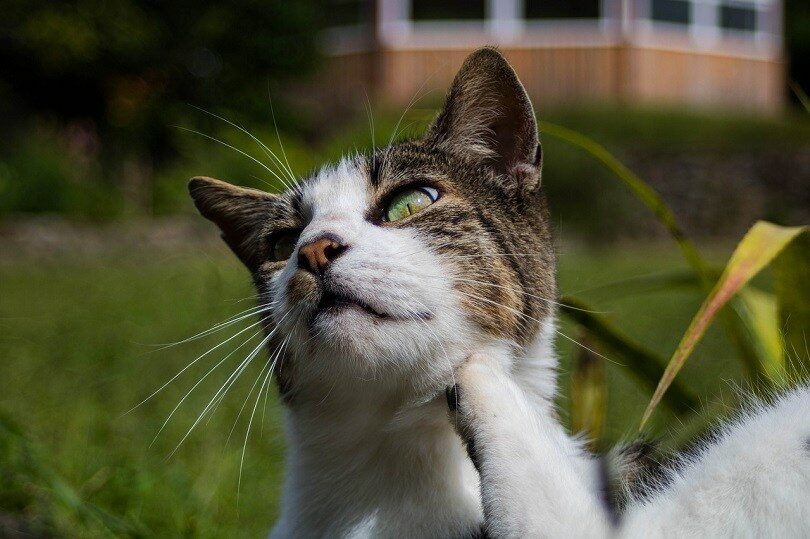What Is Ataxia in Cats? Causes, Symptoms & Treatment (Vet Answers)
By admin / December 21, 2022 / No Comments / Pet Dogs
It can sometimes be tricky to differentiate ataxia from muscle weakness. Ataxic cats typically still have full strength and control of the nerves responsible for movement (motor nerves). What’s missing is the ability to coordinate how their head, body, and limbs are oriented relative to the rest of the world.
What Does Ataxia Look Like?
One of the classic ways people describe ataxic cats is that they appear intoxicated. Symptoms may be present at birth or appear at any time during a cat’s life. Signs can come on suddenly or develop gradually over time.
- Appear unsteady and sway on their feet
- Lean to one side
- Walk in circles
- Stumble or fall over
- Drag their paws when walking
- Stand with an abnormally wide stance
- Show a reduced appetite and/or vomiting

Specific types of ataxia may cause a head tilt and abnormal eye movements
Ataxia is a serious neurologic symptom. If your cat is showing any of the signs listed above, please seek veterinary attention immediately.
The Different Types of Ataxia
There are three main types of ataxia, based on which part of the nervous system is affected. Identifying the type of ataxia helps narrow down the possible causes, which determines treatment options and the likelihood of recovery.
1. Vestibular ataxia
A cat’s vestibular system helps them determine how their head and body are positioned relative to their surroundings, which allows them to coordinate appropriate movement and maintain their balance. The vestibular system includes the medulla (located in the brainstem), as well as the middle and inner ear.
- Head tilt
- Circling
- Leaning, falling, or rolling
- Rapid involuntary eye movements (nystagmus)
Vestibular ataxia is subcategorized into:
Central vestibular ataxia
This type of ataxia occurs when the brainstem is affected. In addition to the classic symptoms of vestibular ataxia listed above, these cats may appear mentally subdued or drowsy.
- Tumor in or around the brainstem
- Trauma (directly to the brainstem or secondary to something affecting the whole brain, e.g., swelling)
- Viral infection (e.g., feline infectious peritonitis)
- Thiamine deficiency (relatively rare, but can occur in cats fed exclusively raw fish)
- Protozoal infection (e.g., toxoplasmosis)
- Fungal infection (e.g., cryptococcosis)
- Parasite migration in the brain (e.g., Cuterebra larvae)
- Toxicity (e.g., metronidazole)

Peripheral vestibular ataxia
This type of ataxia occurs when the middle and/or inner ear is affected. In addition to the characteristic symptoms of vestibular ataxia, these cats may also show signs of Horner’s syndrome if nerves in the face are affected.
Here are some common causes of peripheral vestibular ataxia in cats:
2. Cerebellar ataxia
Another part of the brain, the cerebellum, coordinates fine muscle movements. An interesting feature of cerebellar ataxia is that affected cats may look normal at rest, with symptoms becoming apparent during movement.
Symptoms of cerebellar ataxia include tremors (affecting the head, body, and limbs), overly exaggerated steps when walking, and standing with the feet wide apart for balance.

Here are some of the conditions causing cerebellar ataxia in cats:
- Cerebellar hypoplasia (kittens born with an underdeveloped cerebellum, typically due to the mother becoming infected with feline panleukopenia virus during pregnancy)
- Tumor (originating in the cerebellum or secondary to another cancer in the body)
- Trauma (directly to the cerebellum or secondary to something affecting the whole brain, e.g., swelling)
- Viral infection (e.g., feline infectious peritonitis)
- Protozoal infection (e.g., toxoplasmosis)
- Fungal infection (e.g., cryptococcosis)
- Parasite migration in the brain (e.g., Cuterebra larvae)
- Toxicity (e.g., metronidazole)
3. Proprioceptive ataxia
Proprioception can be explained as knowing where the body is located in space.
The differentiating feature of proprioceptive ataxia is that the head is not affected, only body parts below the neck. Cats may drag their feet or cross them over each other when walking.
Proprioceptive ataxia results from damage to, or compression of, the spinal cord.

Some examples include:
- Traumatic injury (e.g., hit by a car)
- Tumor in or around the spinal cord
Although rare in cats compared to dogs, proprioceptive ataxia can also be caused by lumbosacral stenosis, intervertebral disc disease (IVDD) or fibrocartilaginous embolus (FCE).
How Do Veterinarians Determine the Cause of Ataxia?
The veterinarian will ask you questions to establish a complete history of your cat’s symptoms. They will observe your cat’s movements and examine them thoroughly. A special neurologic exam will help them determine which part of the nervous system is affected.
Further tests may be needed to help determine the exact cause of the ataxia, including:
- Blood and urine analysis
- Radiographs (x-rays)
- Computed tomography (CT) scan
- Magnetic resonance imaging (MRI) scan
- Cerebrospinal fluid (CSF) testing

In some cases, you may be given the option of referring your cat to a veterinary neurologist. However, it is important to consider that this type of referral often requires a large financial commitment.
How Is Ataxia Treated in Cats?
There is no one, single treatment for ataxia. Treatment depends on the underlying cause.
Idiopathic vestibular disease may simply require some supportive care while waiting for symptoms to resolve on their own (often within a few weeks). Other forms of ataxia may require medication or surgery. Some conditions, like cerebellar hypoplasia, unfortunately have no cure.
Do Cats Recover from Ataxia?
Prognosis depends on the cause of the cat’s ataxia. Some cats can be expected to make a full recovery (e.g., in the case of idiopathic vestibular disease), while other conditions unfortunately have no cure (e.g., cerebellar hypoplasia).
The most important consideration is whether the cat will be able to maintain a good quality of life. Your veterinarian will explain your cat’s condition, treatment options, and prognosis for recovery.

Featured Image Credit: Dorottya Mathe, Shutterstock
